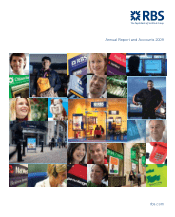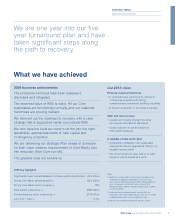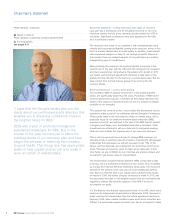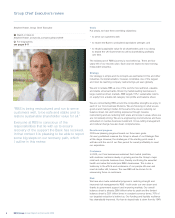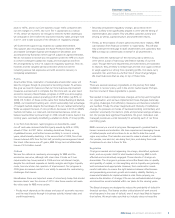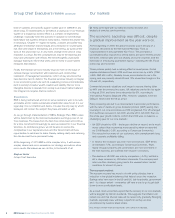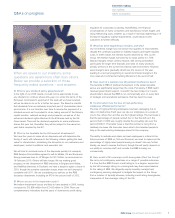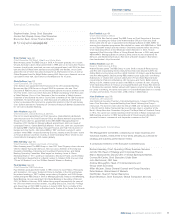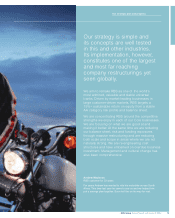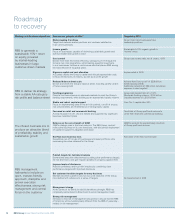RBS 2009 Annual Report Download - page 7
Download and view the complete annual report
Please find page 7 of the 2009 RBS annual report below. You can navigate through the pages in the report by either clicking on the pages listed below, or by using the keyword search tool below to find specific information within the annual report.
5RBS Group Annual Report and Accounts 2009
Essential reading
Group Chief Executive’s review
peak to 135%, and in our Core business is just 104% compared with
our 2013 target of c.100%. Our Core Tier 1 capital ratio is a robust
11.0%, which we expect to be enough to meet the further challenges
we anticipate in 2010 before the expected recovery takes stronger hold
in 2011, and to take account of the direction of regulatory change.
UK Government support has enabled our capital improvement.
This support also encompasses the Asset Protection Scheme (APS)
and related Contingent Capital Line finalised in December, and
accompanied by European Union sign-off, subject to agreed remedies.
We do not expect to receive any net payment under the APS or to have
to convert contingent capital into equity, and we target an exit from
the arrangements by 2012/13, subject to regulatory approval. They do,
however, provide valuable tail risk protection whilst we exit the
remaining excess risk exposures and until economic recovery is
completely established.
Profits
Goal number three, restoration of sustainable shareholder value, will
take the longest, though its prospect is becoming clearer. To achieve
this goal we need to make sure that our Core business improvement
measures succeed and to complete the Non-Core exit; we also need
economic recovery. Nevertheless, progress in 2009 was encouraging.
Our Core business posted operating profit of £8.3 billion (up 89% on
2008). £5.7 billion of these profits came from Global Banking & Markets
(GBM), our investment banking arm, which successfully took advantage
of buoyant markets despite the handicaps of its own radical restructuring.
While we expect this level of core profits to decrease in 2010 as GBM’s
markets normalise, our retail and commercial businesses, which we
believe reached their cyclical trough in 2009, should bounce back in the
coming years, eventually constituting a stable two-thirds of Group profits.
In our Non-Core Division, rapid progress on divestments, asset
run-off and sales reduced total third party assets by 36% in 2009,
ahead of Plan, to £221 billion, including derivatives. Doing so
crystallised losses, and further losses are likely to occur in coming
years, albeit steadily declining. In the second half of 2009, Non-Core
losses reduced 44% from the first half, providing encouragement about
this trend. After some one-off gains, RBS Group had net attributable
losses of £3.6 billion overall.
Outlook
We see the outlook as cautiously encouraging for RBS and the
economies we serve, although with clear risks. It looks as if loan
impairments may have peaked in 2009 and our net interest margin,
despite the continued squeeze on liability margins and higher liquidity
costs, has now shown two quarters of improvement. Our progress in
2009 gives increased comfort in our ability to execute the restructuring
challenges that remain.
Nonetheless, there are important areas of uncertainty today that should
become clearer over the course of 2010. How these resolve will make
the value case for RBS more certain.
•Firstly, much depends on the shape and pace of economic recovery
and the way it feeds through to business activity, interest rates and
credit impairments.
•Secondly, prospective regulatory change, about which more
below, is likely to be significantly shaped in 2010 with the timing of
implementation also clearer. This will affect customer activity and
pricing as well as capital structure and shareholder returns.
•Thirdly, as the prospect of share sales becomes more realistic, RBS
can transition from financial ‘problem’ to ‘opportunity’. This will also
help underpin the message to staff, shareholders and customers that
RBS is being run commercially on behalf of all shareholders.
•Finally, while the riskiest part of the recovery plan is behind us,
2010 will be a year of hard slog, with limited visibility of our end
value. Though Non-Core impairments and write-downs are expected
to improve, they are likely to remain high and will once again continue
to weigh against our strong Core operating profits. Our plans carry
execution risk, and there is a further risk of sheer change fatigue.
We must make sure that we stay on top of these risks.
People
There are several necessary ingredients on the journey from failed
institution to recovery story, and in the end to market leader. Perhaps
the most crucial of these ingredients is people.
We needed to make comprehensive changes at the top and throughout
our organisation, and we have implemented these changes decisively.
On-going challenges from efficiency measures and business reduction
are manifest. Finally, the sheer magnitude and intensity of institutional
change, the pressure on morale of backward-looking commentary and
customer uncertainty, the dents to pride and personal savings all take a
toll. Our people face significant headwinds. Yet good, motivated, well-
managed people are a vital necessity for achieving each of our three
overriding goals.
RBS’s recovery is a work in progress. Management’s greatest task is
human renewal and motivation. We have experienced damaging losses
of skilled people and will continue to do so. But to date the overall
signs are positive. The transition we need to make is ahead of schedule.
Our people, new and old, are doing their jobs, and doing them well.
Compliments are due to them for this.
Regulation
Change is needed and is happening. As a large, diversified, systemic
bank, and as a poster child for what needed reforming, RBS is both
affected and constructively engaged. Three strands of change are
discernible. The changes in process around the Basel rules on quality
and quantity of capital, on risk weighting and on liquidity are generally
well conceived and appropriate. However, their combination needs
careful calibration to ensure the right balance between effectiveness
and jeopardising economic growth and industry stability. Similarly, a
measured timetable for implementation is vital. Done properly, we
welcome the direction of change; it fits our own self-administered change
and should be accommodated within our plans for the coming years.
The Basel changes are designed to reduce the probability of default in
financial services. That leaves another critical strand of work around
what happens in the case of default, even if much less likely to happen
than before. We must make sure that our industry does not need the

